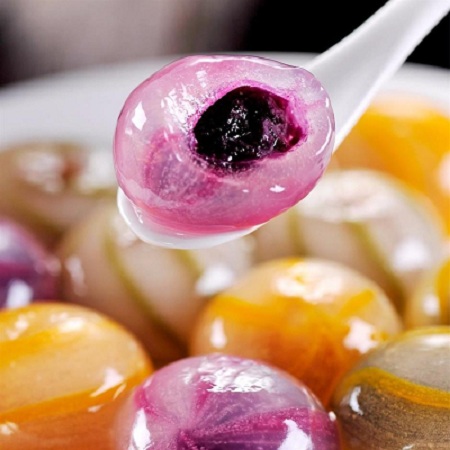
Crystal tangyuan uses tapioca flour or lotus root flour instead of the traditional glutinous rice flour.(Ti Gong)
The Lantern Festival marks the final day of the Chinese New Year celebrations. On this day, glutinous rice balls will be the centerpiece dish in most Chinese households.
Falling on the 15th day of the first month on the lunar calendar, the Lantern Festival has a history of more than 2,000 years.
It’s said that Emperor Wen of the Western Han Dynasty (206 BC-AD 24) created the festival after squashing a revolt led by the Lu family that ended on the 15th day of the first lunar month. He ordered that the day be a celebration for all the people and households would hang lanterns to display their cheerful spirit.
Emperor Wu, Wen’s grandson, designated the Lantern Festival as an official imperial worship of Taiyi, or the Great Oneness, the highest Taoist god and controller of the destiny of the humanity.
Taiyi was the first god described in “Jiu Ge,” or “Nine Songs,” an ancient set of poems first published under the title “Chu Ci (Songs of Chu)”.
In the legend, Taiyi was the god making decisions regarding when to inflict drought, storms, famine or pestilence upon humans.
Since the Warring States Period (476-221 BC), ceremonies had been held to worship Taiyi and the emperors would ask him for favorable weather and good health for them and their people.
When Sima Qian, a historian during Emperor Wu’s reign, created the Taichu calendar, which was a revolution in Chinese calendar tradition, the Lantern Festival was already an important holiday.
Special events are hosted to celebrate the Lantern Festival, which is also the first full moon of the new year. The most important tradition in celebrating the Lantern Festival, from ancient times to today, is displaying colorful lanterns.
The lanterns can be made of various materials from paper, glass and even jade, and they are painted with eye-catching figures, animals and tales. Lantern fairs immerse visitors in an ocean of traditional and creative designs.
Solving lantern riddles is another fun activity during the festival.
The riddles are often written on red strips of paper that are then fixed onto the lanterns, attached by strings. In the Tang Dynasty (AD 618-907), guessing riddles was a contest of wisdom among men, and in the Song Dynasty (AD 960-1279), people from all walks of life took part in the game.
The ancient riddles were very difficult to solve, as they required a significant amount of classical knowledge and wit. The answer could be a single word, a verse from a poem, a name or object. Today, the riddles are simpler and also include puns and homophones.
In southwestern provinces, some people have the tradition of holding torches made from tree branches and dancing in the fields with the hope of driving away the pests and beasts and praying for a good harvest in the coming year. This custom was widely practiced in the Sui, Tang and Song dynasties.
The boat dance is another Lantern Festival custom in Shaanxi, Shanxi and Hebei provinces that imitates the moves of rowing a boat on land. The boat is usually made from two thin boards carved in the shape of a boat, then wrapped in colorful fabric and attached to the performer’s waist. The boat dance is usually performed by females.
Traditional lion and dragon dances are also staged in some places to celebrate the Lantern Festival, as they are auspicious figures in Chinese culture.


















































